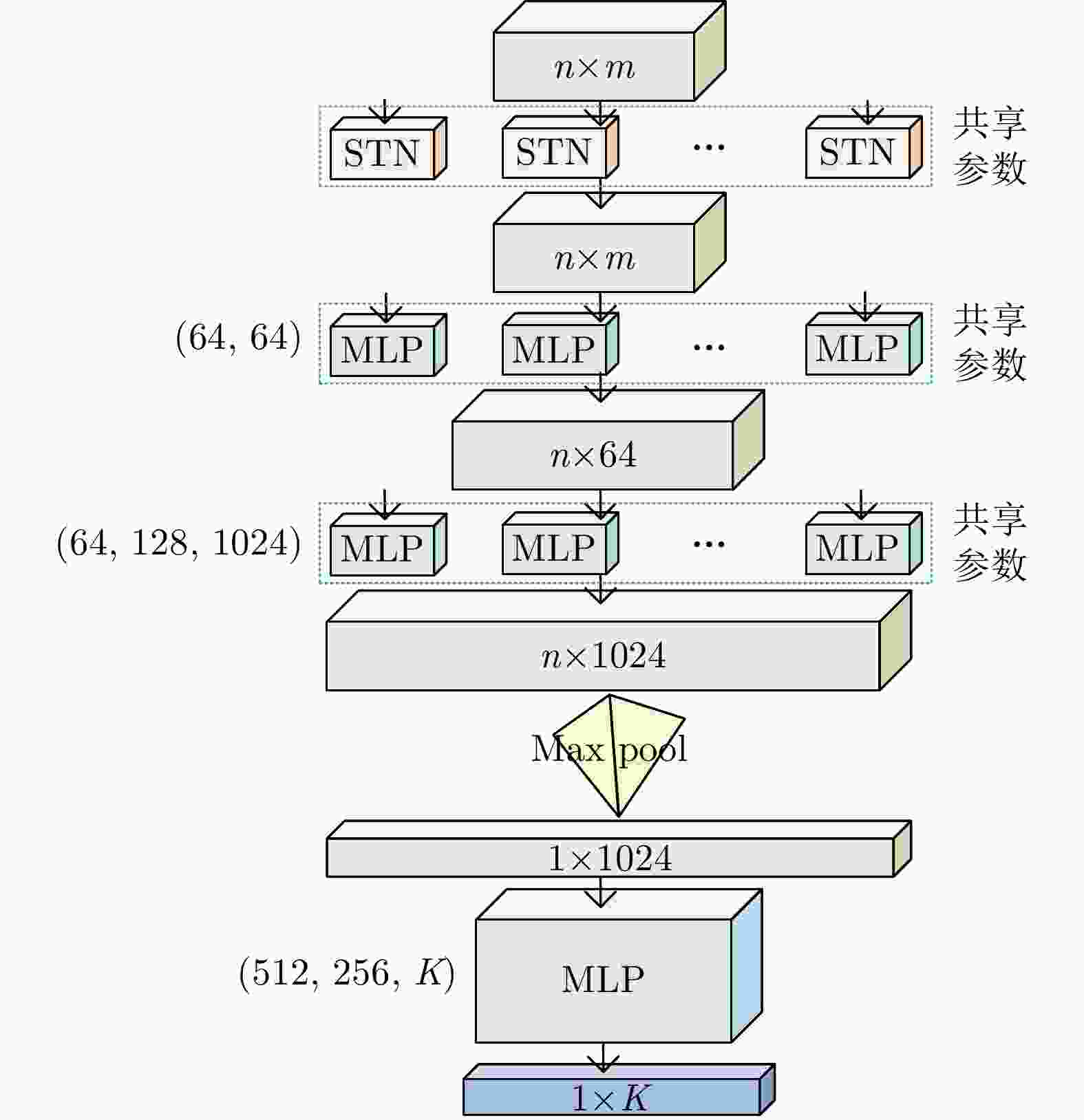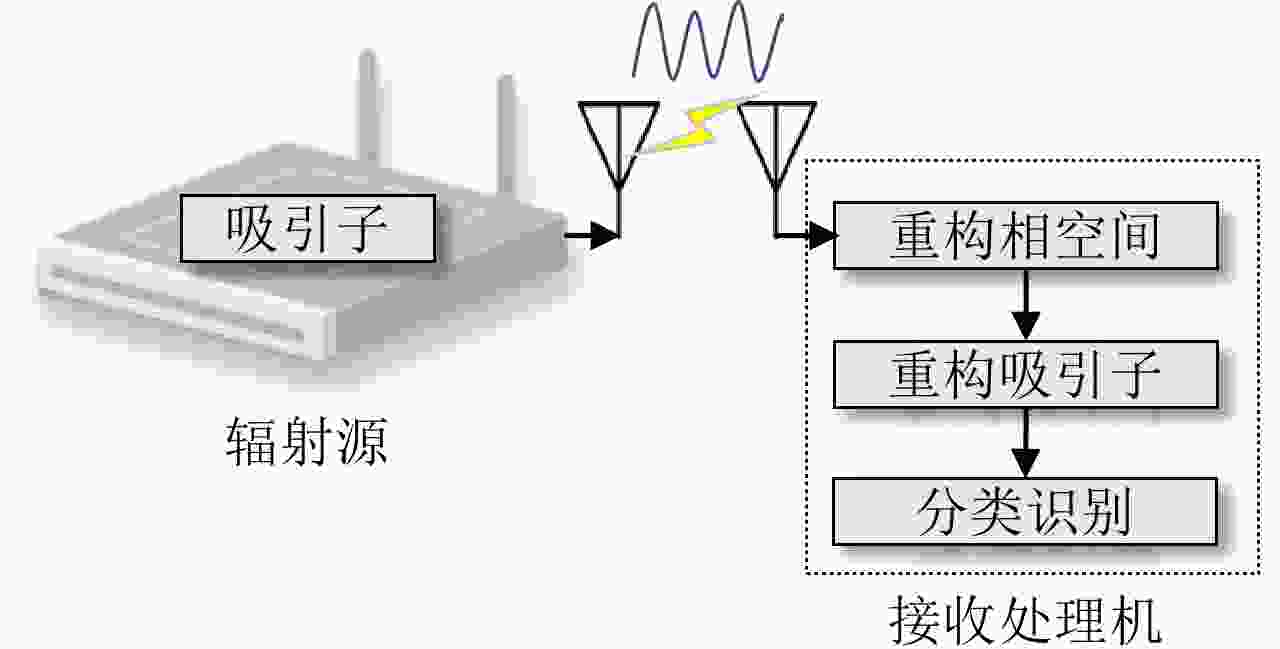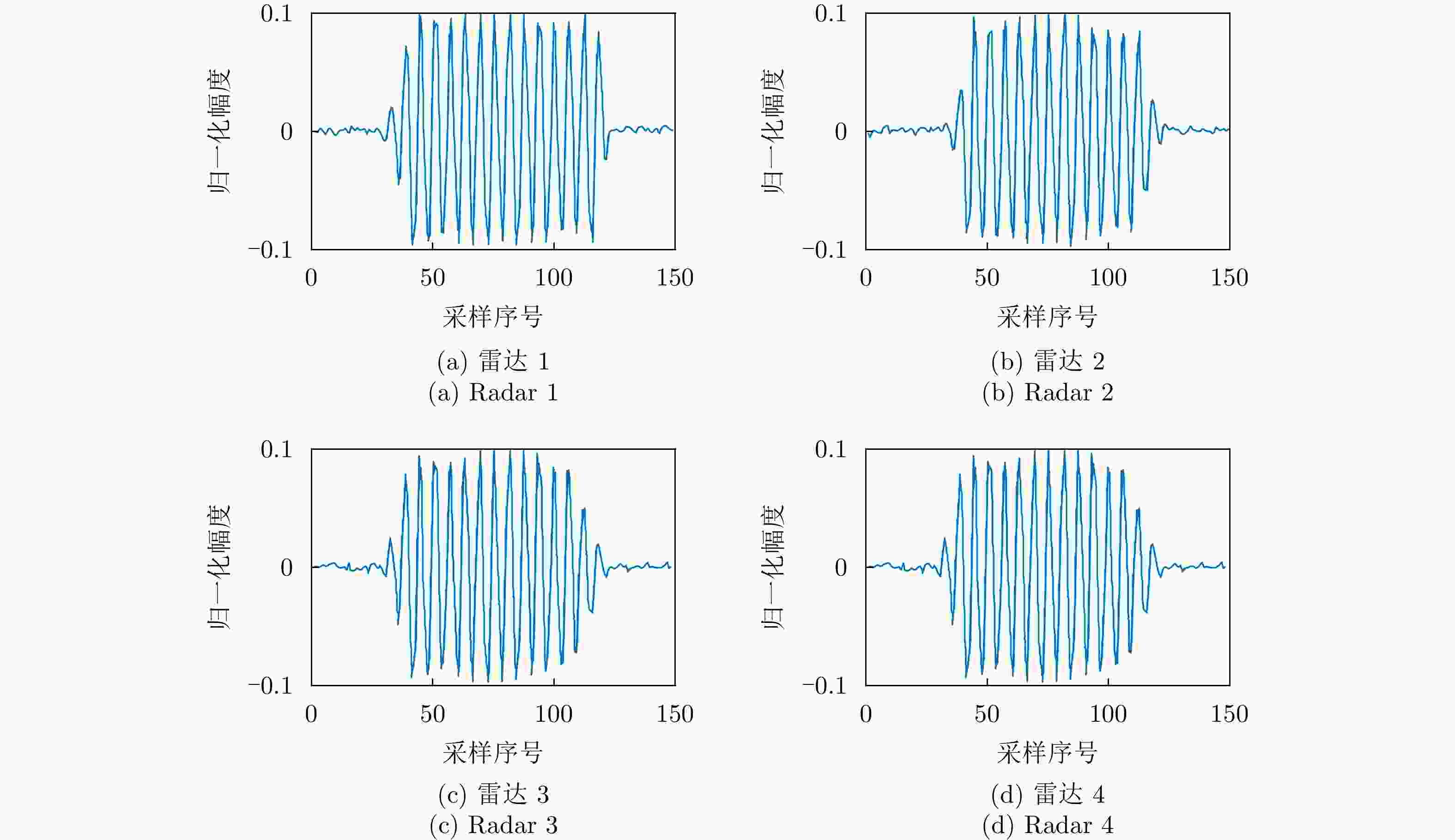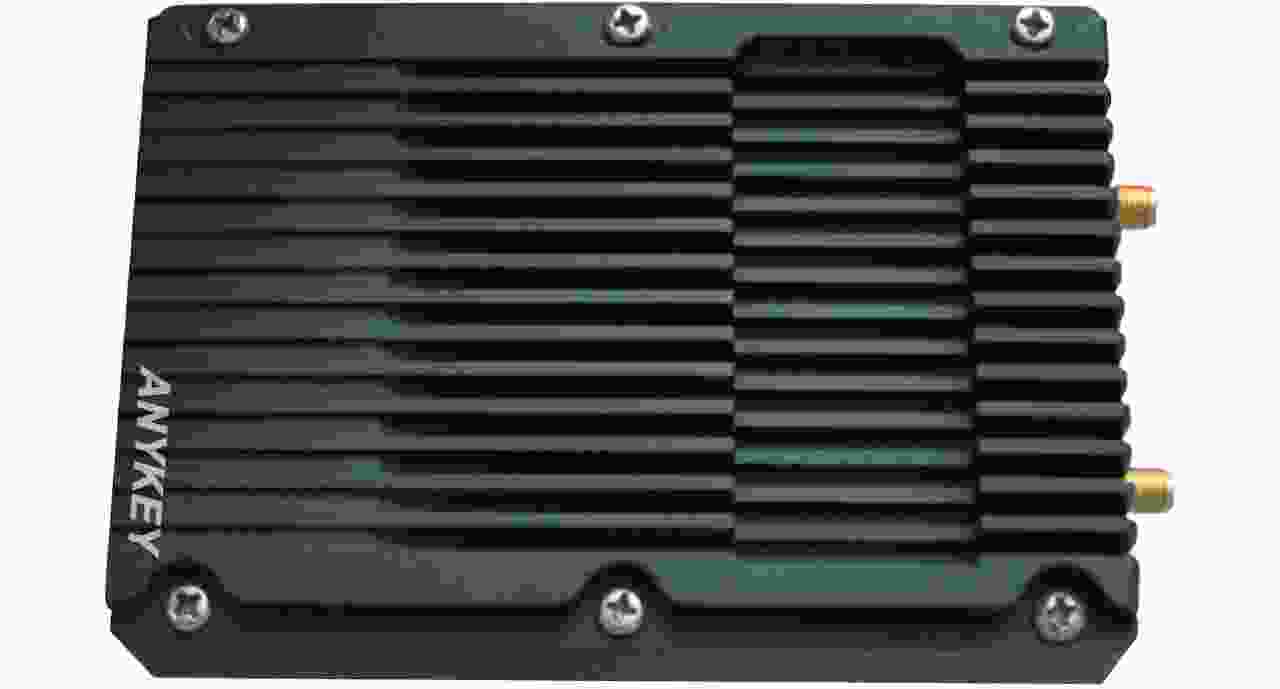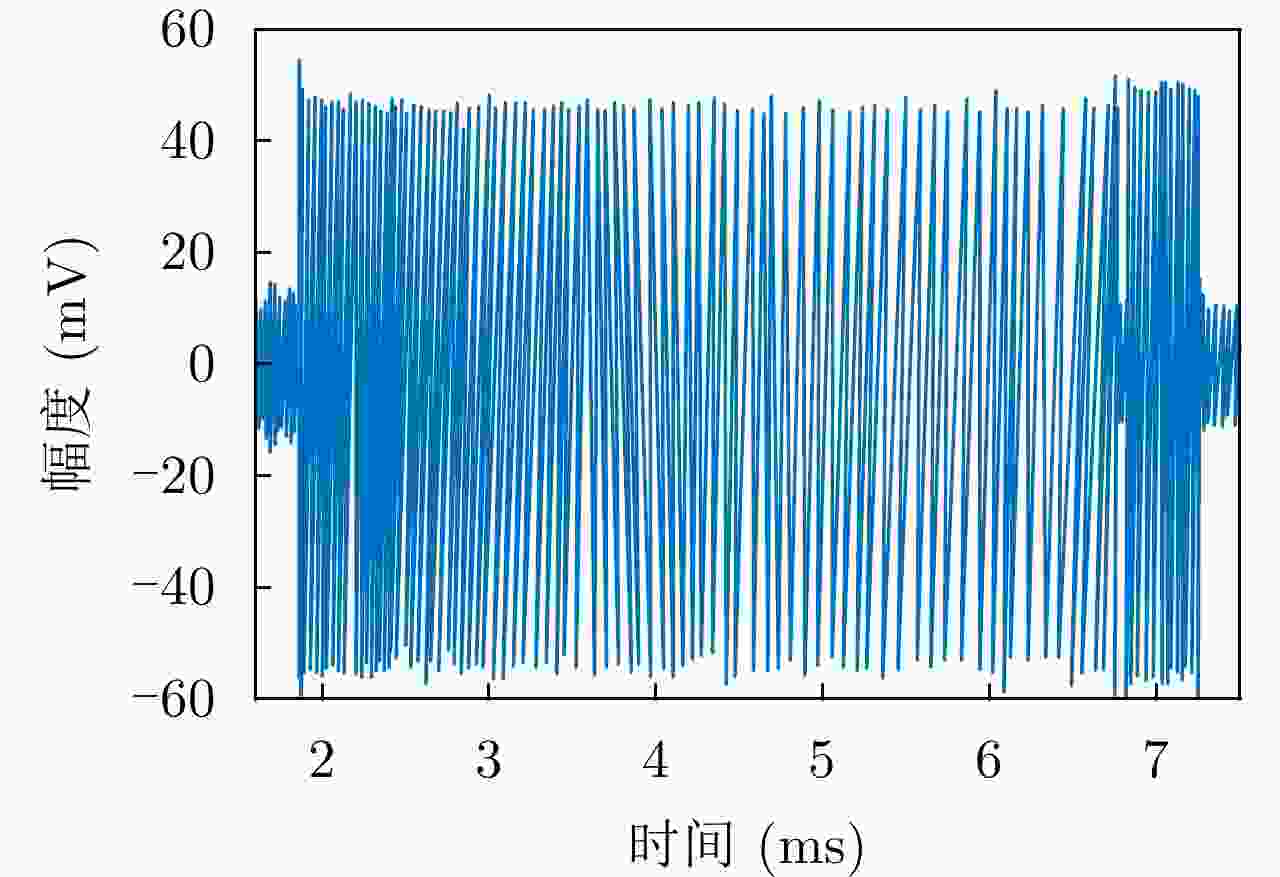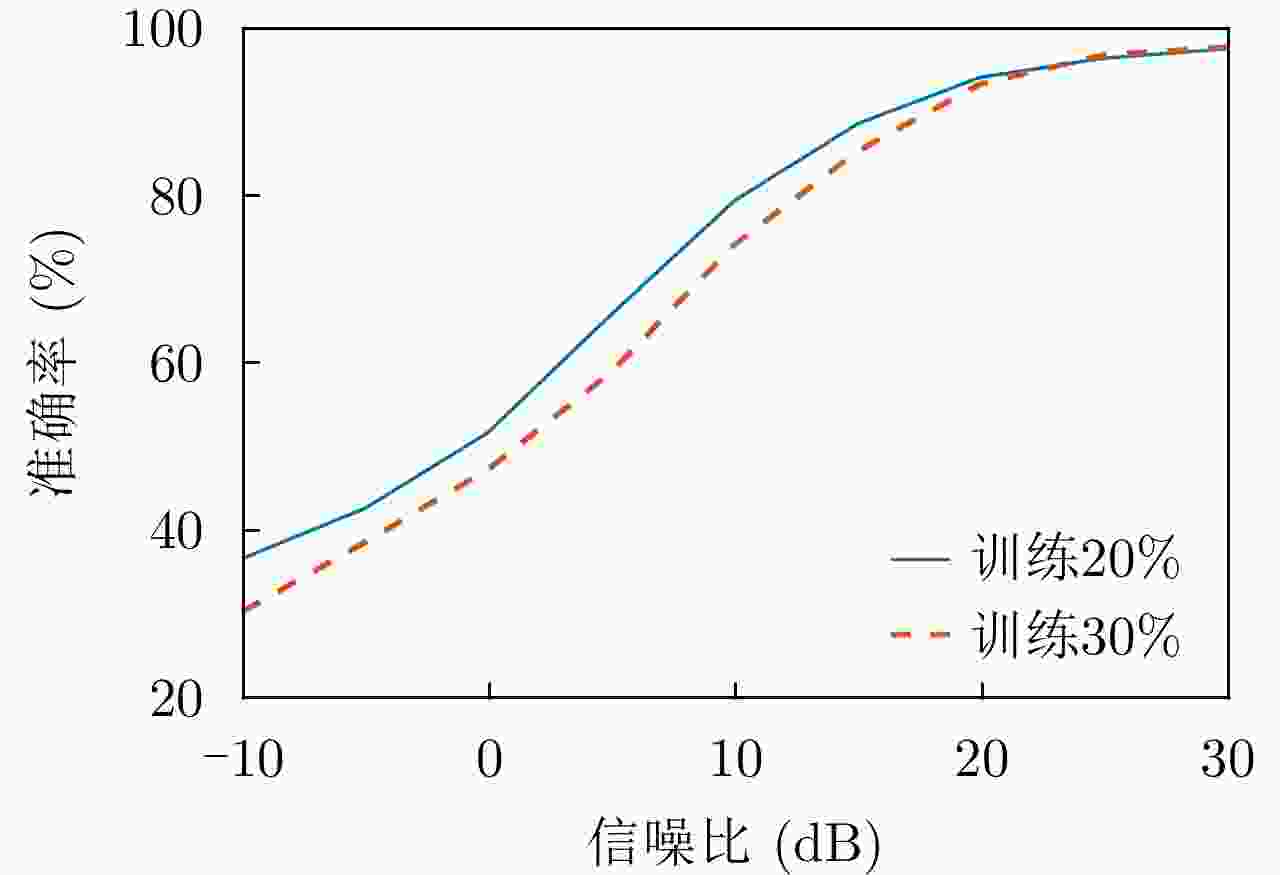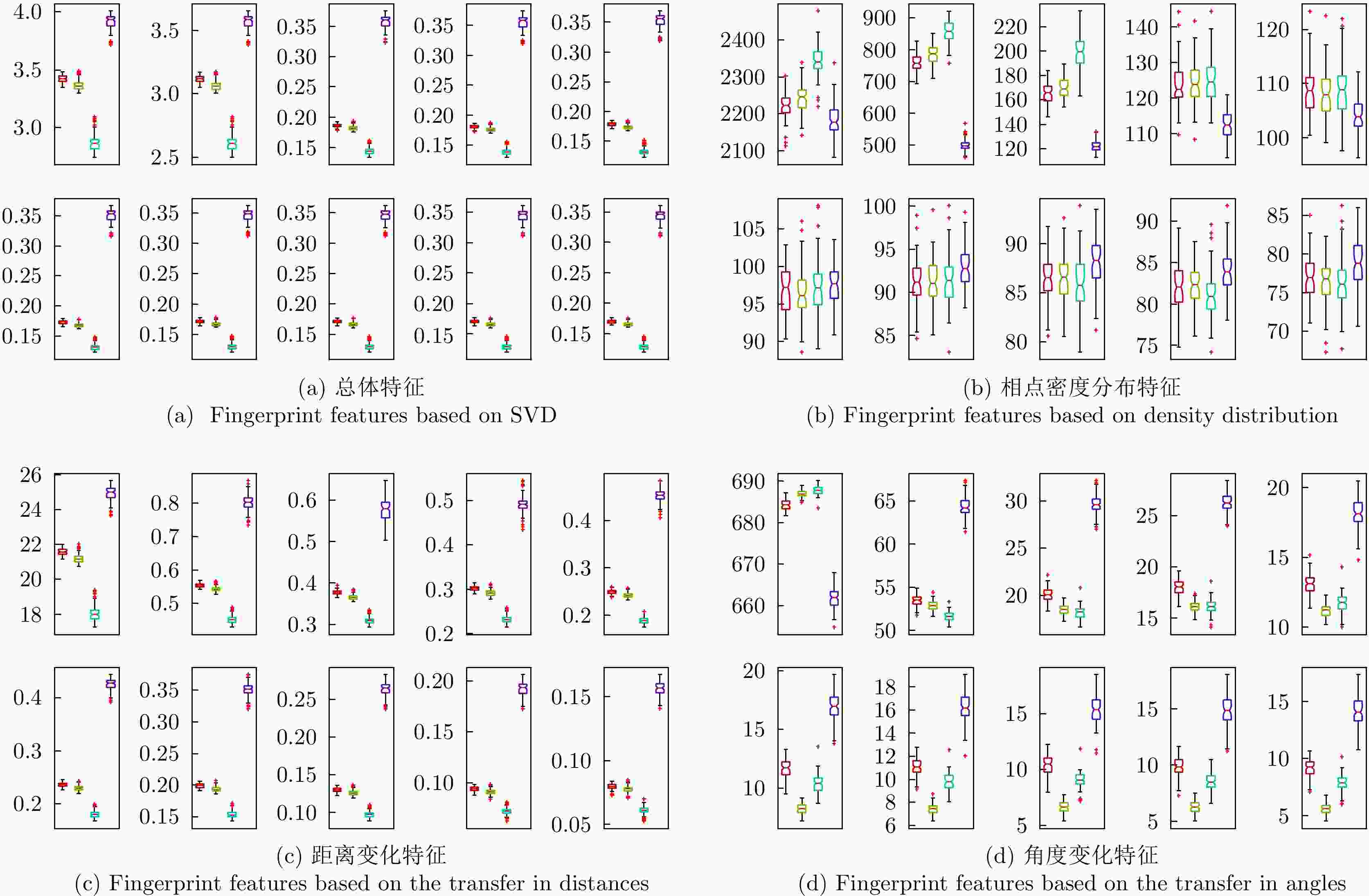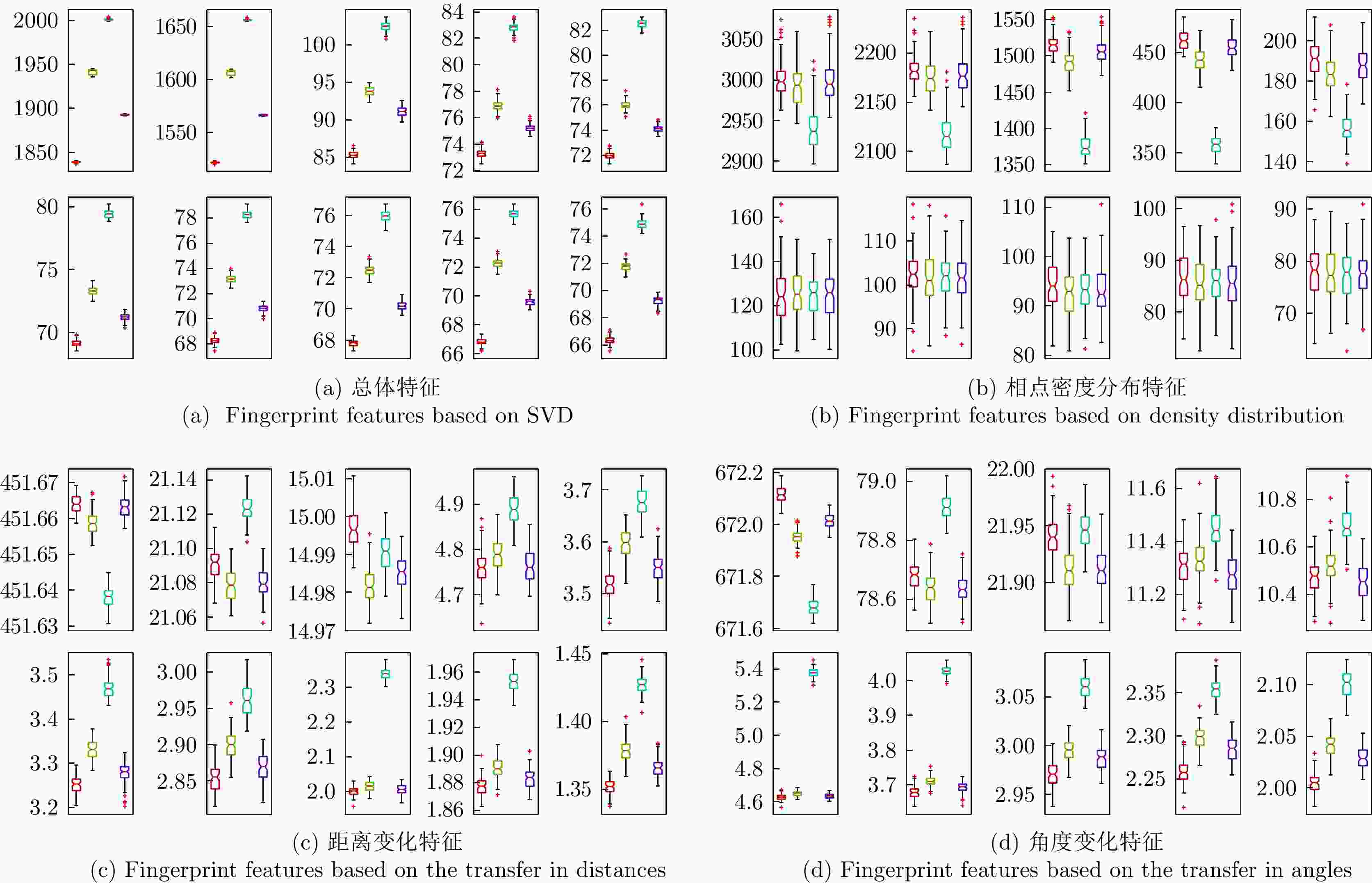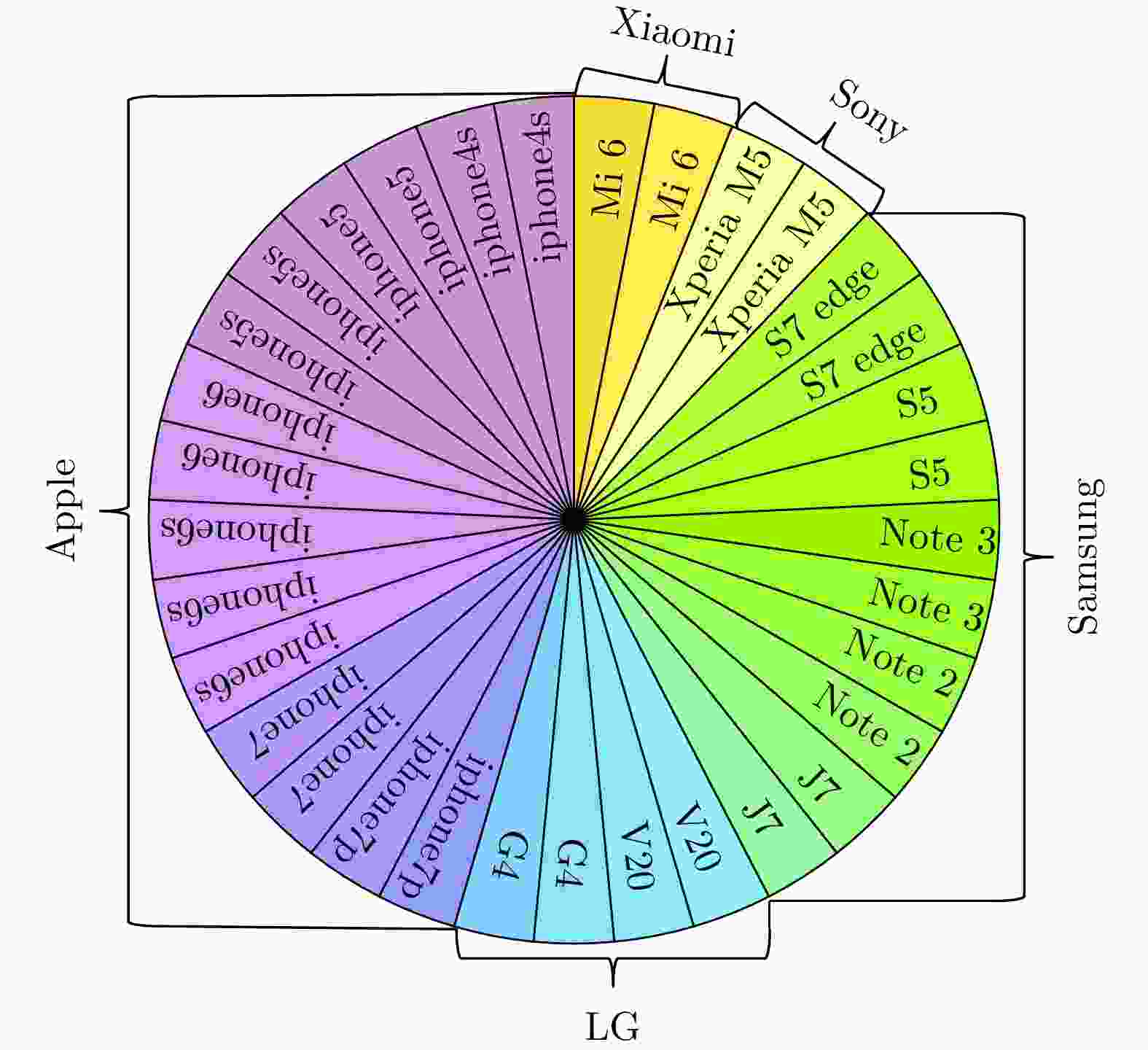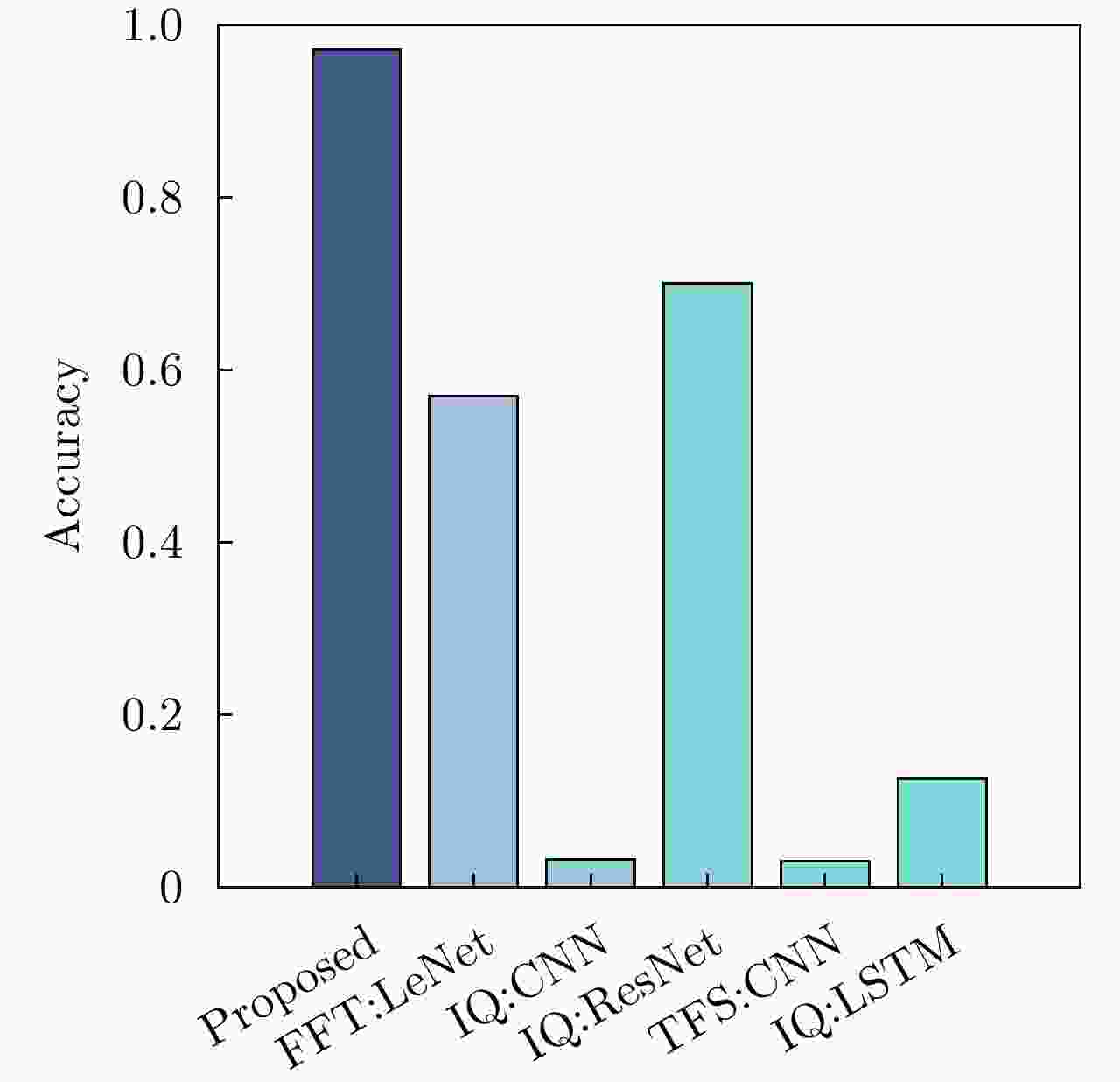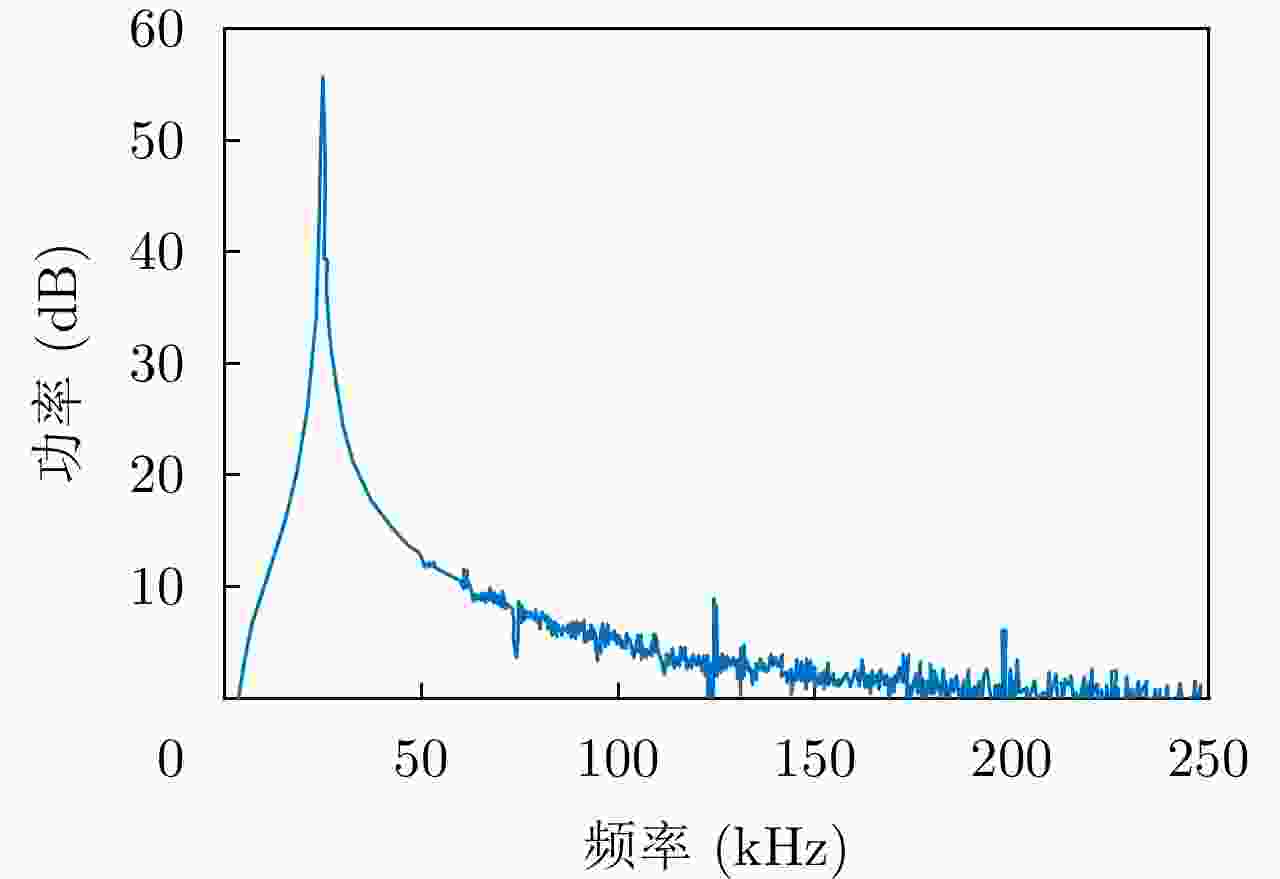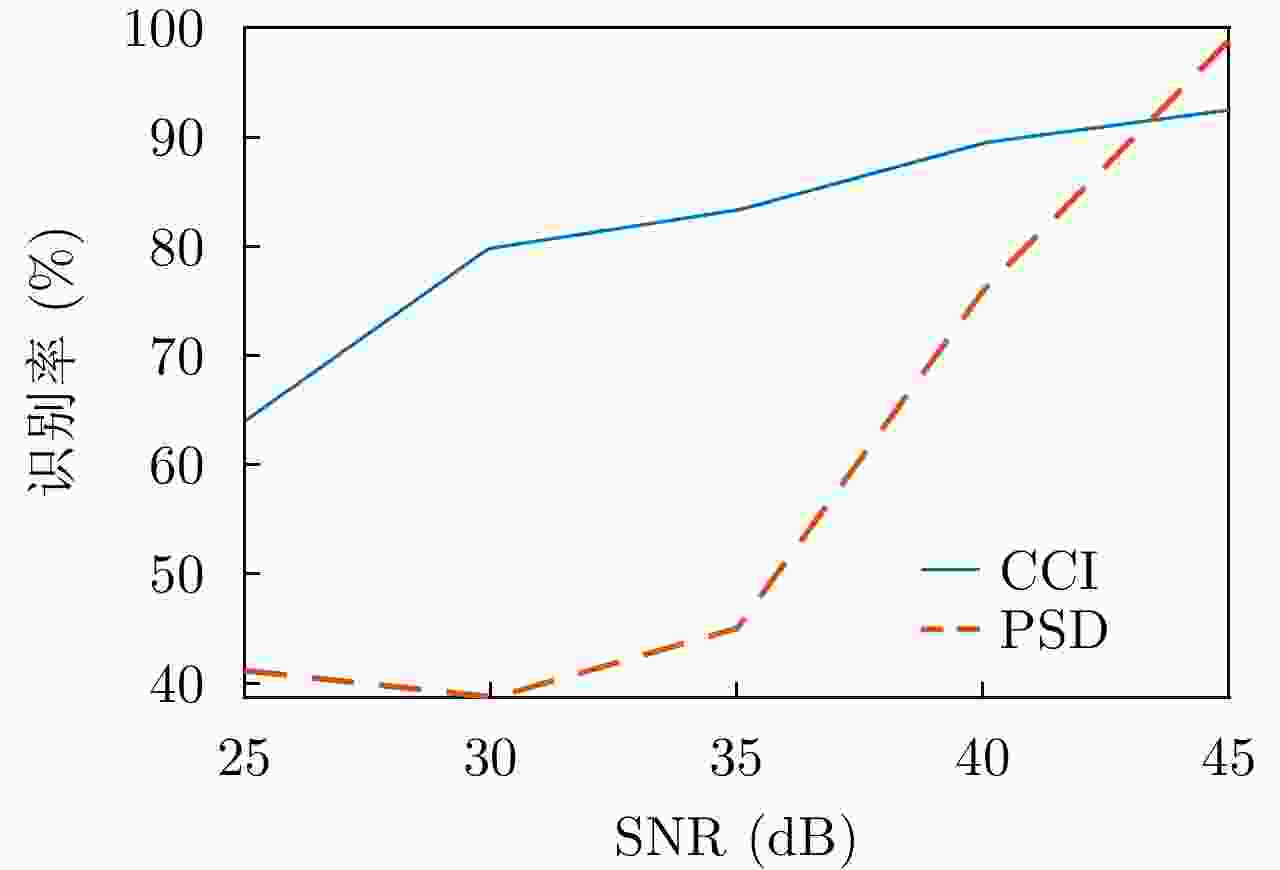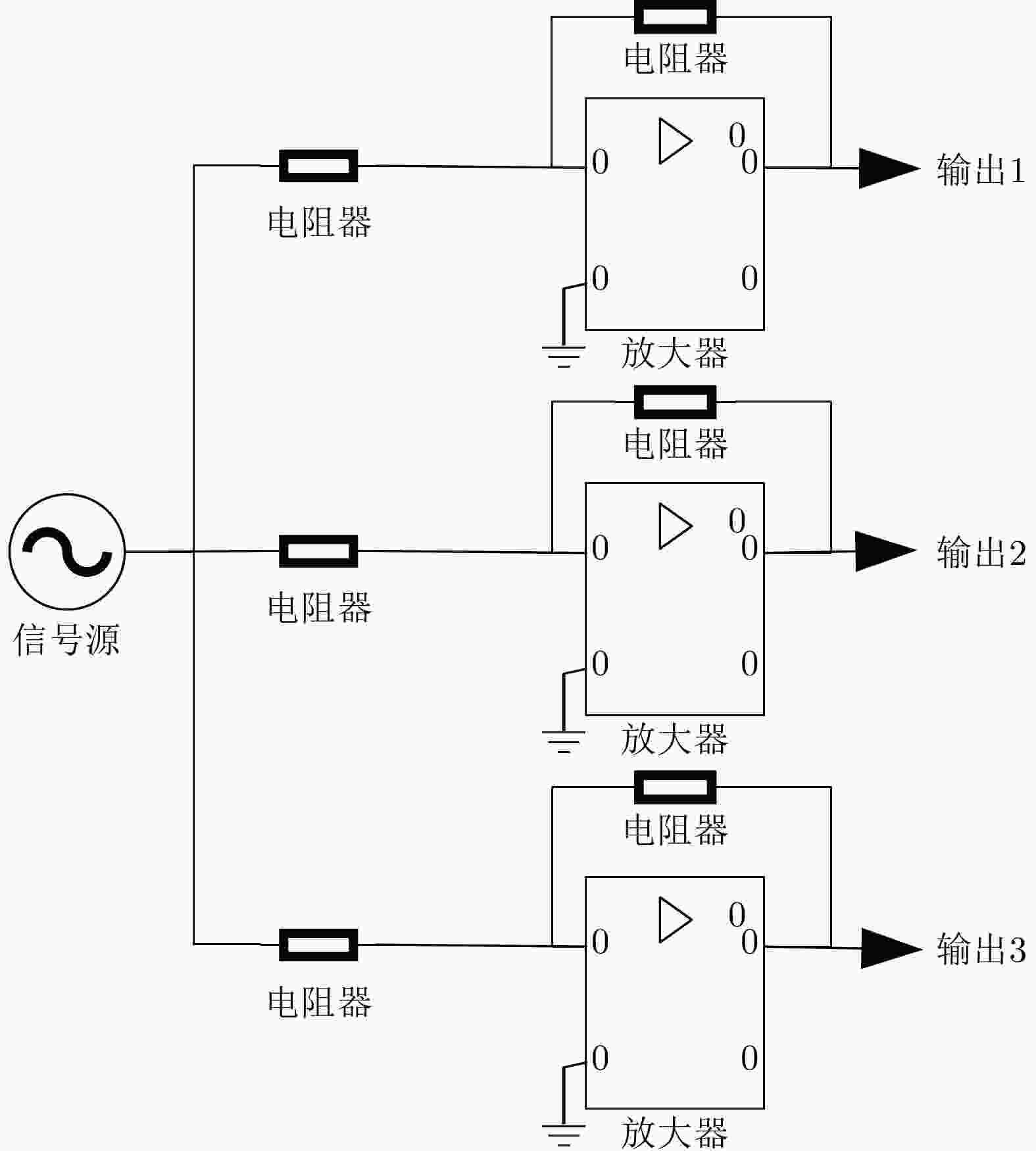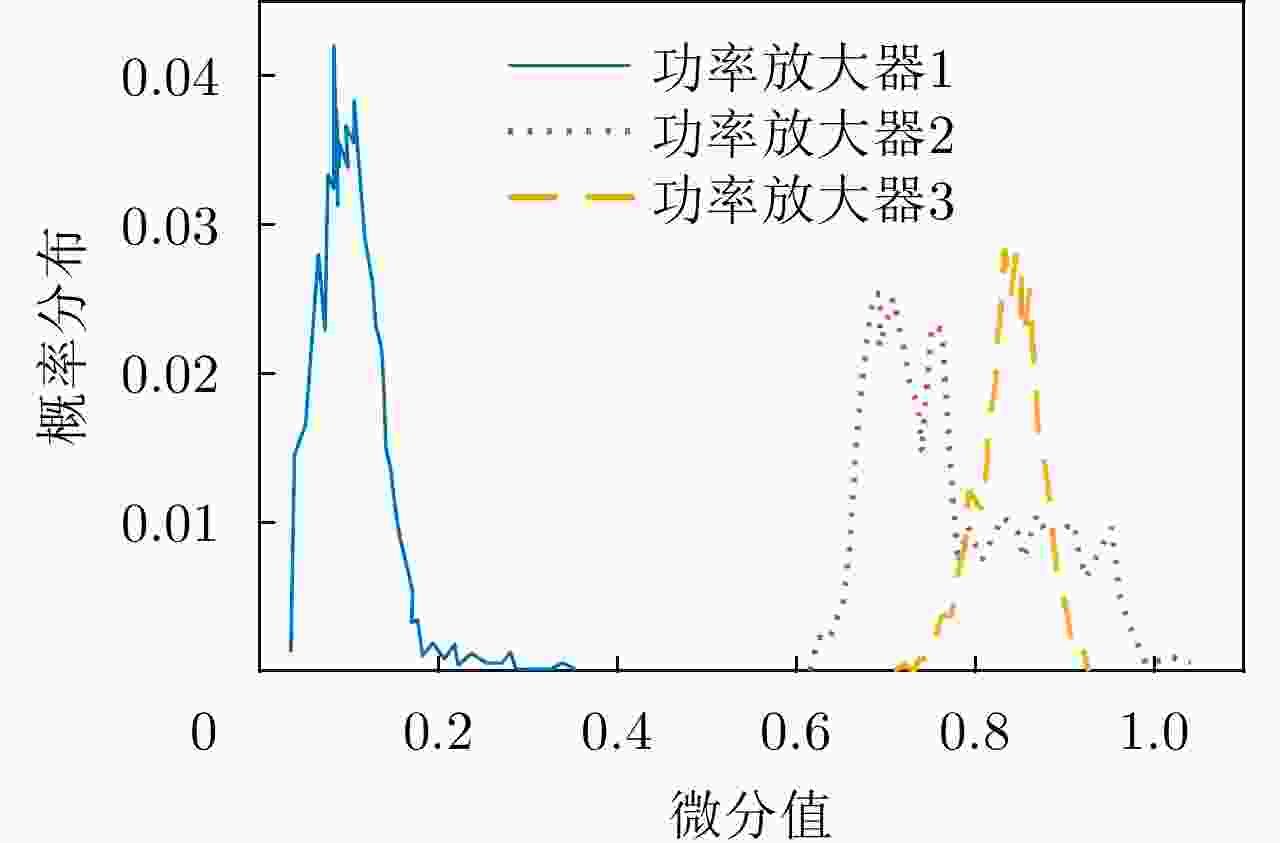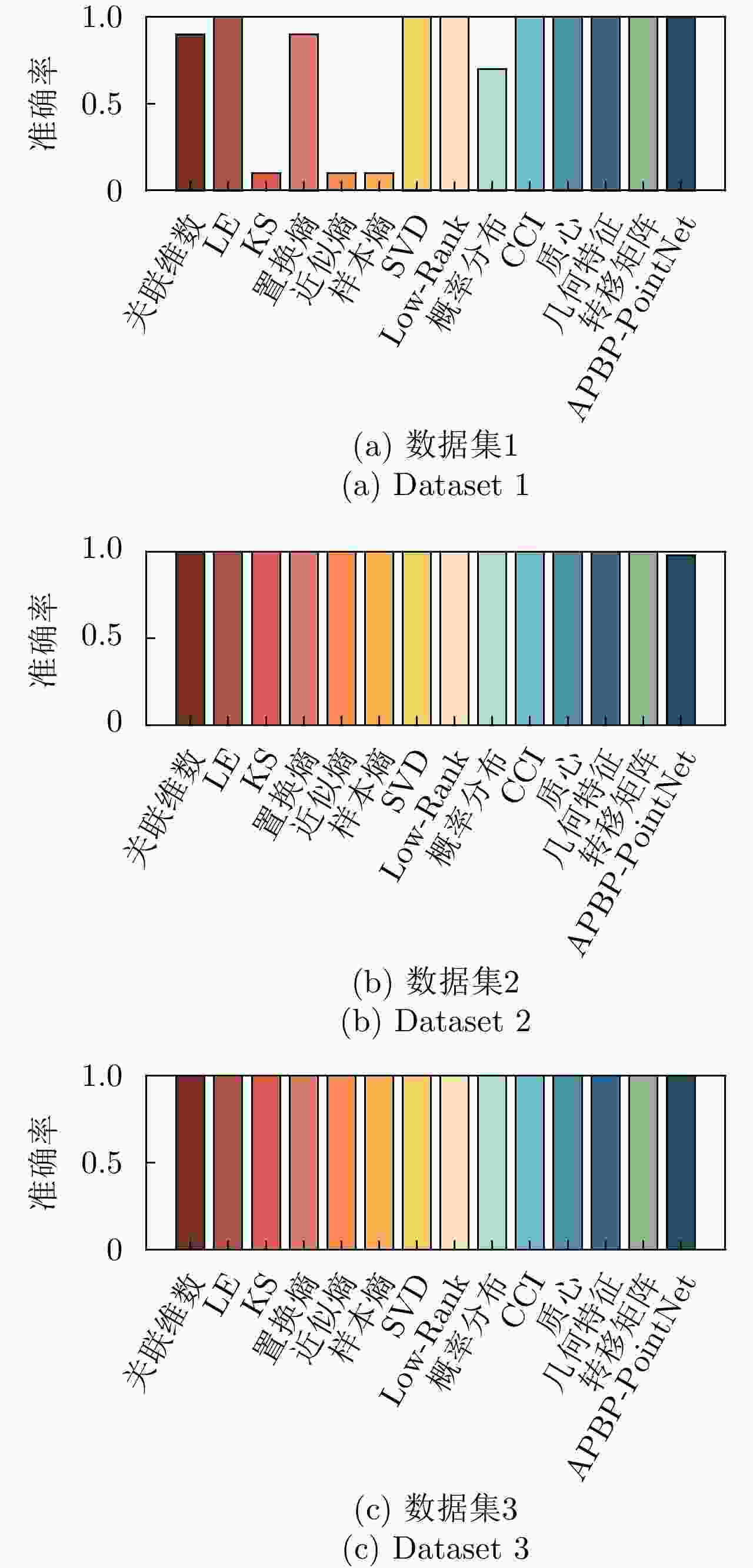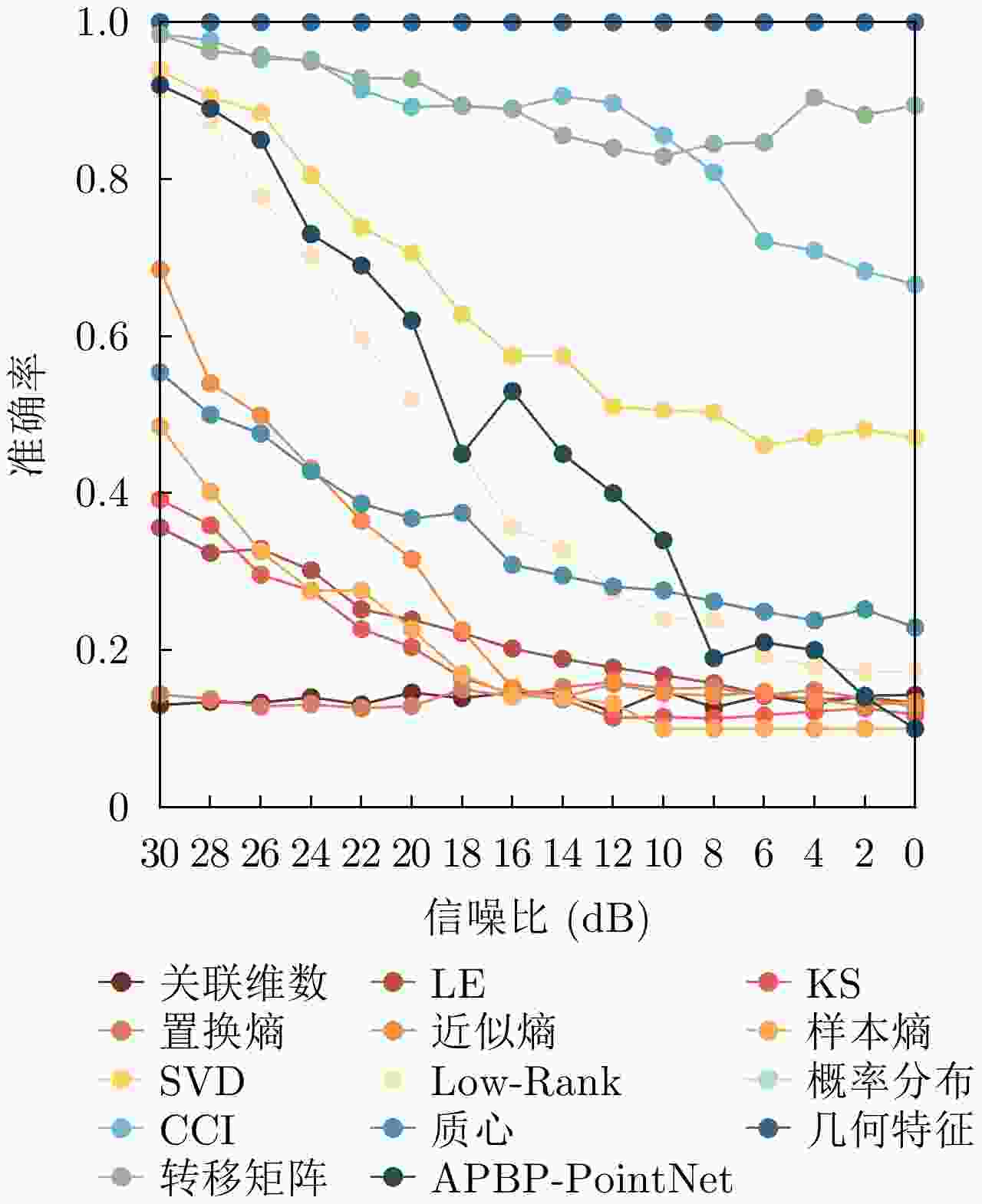-
摘要: 辐射源个体识别技术,起源于雷达目标精确辨识任务,旨在根据截获的电磁信号提取辐射源独有的指纹特征,并进一步辨识辐射源个体身份的技术。相空间重构技术,作为一种有效的时间序列分析技术,可以从一维时间序列中重构一个与原系统非线性动力学特性相同的相空间。相空间重构技术自2007年开始被诸多学者引入辐射源个体识别问题中。然而,该项技术研究时间较短且分布较为分散,尚未形成清楚的发展脉络。对此,该文旨在系统性地总结归纳基于相空间重构的辐射源个体识别技术。首先,在介绍相空间重构技术的基础上,论述了相空间重构技术应用于辐射源个体识别的理论依据。其次,从方法框架、算法分类、算法应用效果、算法初步对比4个维度,介绍了基于相空间重构技术的辐射源个体识别技术的研究现状。仿真实验结果表明,该项技术能够有效地捕捉辐射源硬件的非理想性,胜任目标精确辨识任务,并可通过特征融合等手段提升算法鲁棒性。最后,总结现有方法的不足并展望其未来发展前景。Abstract: Specific Emitter Identification (SEI), originated from identifying radar systems, is to extract fingerprint features from the intercepted signals for recognizing emitter identifies. Phase Space Reconstruction (PSR) is a powerful technique in time series analysis that can reconstruct a phase space from a one-dimensional time series, preserving the nonlinear dynamic characteristics of the original system. The integration of phase space reconstruction into SEI began in 2007. However, due to the recent and diverse nature of research focused on PSR-based SEI methods, it is challenging to establish a clear context for its development. To address this issue, this paper aims to systematically summarize SEI methods based on phase space reconstruction. First, we introduce phase space reconstruction technology and emphasize the necessity and feasibility of applying it in SEI. Next, we present a comprehensive framework, classification, application, and comparison of PSR-based SEI methods. Simulation experiments demonstrated that PSR-based SEI methods can effectively describe the non-idealities of emitter hardware components and accomplish the target identification task. In addition, we verify that feature fusion enhances the algorithm’s robustness. Finally, we summarize the limitations of existing methods and outline prospects for future development.
-
表 1 基于重构相空间的辐射源个体识别指纹特征总结
Table 1. Summary of the Specific Emitter Identification (SEI) methods based on Phase Space Reconstruction (PSR)
分析角度 特征 描述意义 参考文献 统计特性 关联维数 时间序列的复杂性和自相似性 文献[18,19,41,42] 最大Lyapunov指数 相邻轨迹的平均指数发散率 文献[18,19,41,42] Kolmogorov熵 混动系统的结构复杂程度 文献[18,41,42] 排列熵 描述时间序列的复杂程度 文献[43–45] 近似熵 时间序列波动的规律性和不可预测性 文献[43,46] 样本熵 时间序列波动的规律性和不可预测性 文献[43] 矩阵固有特性 奇异值分解(SVD) 矩阵特征值 文献[46–48] Low-rank子空间 矩阵低秩表示 文献[49] 几何构型 相点分布 相点概率密度分布 文献[48] 质心 重构相空间质心分布 文献[50] 交叉关联积分 相点概率密度分布 文献[51] 几何特征 重构相空间的几何特征 文献[20] 转移特性 相点差分方法 状态矢量的时间微分 文献[17] 相点转移角度与距离 状态转移规律 文献[47,48] 系统等效性 直接识别 状态分布及其转移规律 文献[52] 重构系统吸引子 系统复杂度 文献[53,54] 表 2 基于重构相空间的辐射源个体识别技术在不同数据集上的应用总结
Table 2. Summary of the SEI-PSR applications on various datasets
表 3 CART决策树模型在重构相空间特征下的信号“指纹”识别率(%)
Table 3. Accuracy with the CART decision tree (%)
设备 识别率 雷达辐射源1 99.61 雷达辐射源2 95.89 雷达辐射源3 97.80 雷达辐射源4 94.93 表 4 采用稳态信号进行识别的混淆矩阵(%)
Table 4. Classification confusion matrix of random payload data: Steady-state signal of radios (%)
真实标签 预测标签 R1 R2 R3 R1 94.70 4.72 1.62 R2 2.15 90.91 2.81 R3 3.15 4.37 95.57 表 5 采用握手信号进行识别的混淆矩阵(%)
Table 5. Classification confusion matrix of fixed payload data: Hand-shaking signal of radios (%)
真实标签 预测标签 R1 R2 R3 R1 95.13 3.93 1.55 R2 2.37 91.08 3.02 R3 2.50 4.99 95.43 表 6 不同信噪比下算法识别准确率
Table 6. Classification accuracy with different SNRs
信噪比(dB) 识别率(%) 50 100 40 100 30 100 20 98 10 95 0 75 表 7 不同信号长度、不同待识别个体数目下,所提方法的正确识别率(%)
Table 7. The identification accuracy of proposed method with different signal length and individuals (%)
样本
点数个体数目 3 4 5 6 500 94.72 92.31 89.31 83.25 600 94.78 93.36 90.96 86.03 700 95.56 92.85 92.77 88.12 800 96.50 95.76 93.85 90.04 900 97.22 96.41 94.73 91.78 1000 97.35 96.88 95.18 92.46 -
[1] TALBOT K I, DULEY P R, HYATT M H, et al. Specific emitter identification and verification[J]. Technology Review, 2003, 32(1): 27–33. [2] JAGANNATH A, JAGANNATH J, and KUMAR P S P V. A comprehensive survey on radio frequency (RF) fingerprinting: Traditional approaches, deep learning, and open challenges[J]. Computer Networks, 2022, 219: 109455. doi: 10.1016/J.COMNET.2022.109455 [3] 史亚, 张文博, 朱明哲, 等. 雷达辐射源个体识别综述[J]. 电子与信息学报, 2022, 44(6): 2216–2229. doi: 10.11999/JEIT210161SHI Ya, ZHANG Wenbo, ZHU Mingzhe, et al. Specific radar emitter identification: A comprehensive review[J]. Journal of Electronics &Information Technology, 2022, 44(6): 2216–2229. doi: 10.11999/JEIT210161 [4] 孙丽婷, 黄知涛, 王翔, 等. 辐射源指纹特征提取方法述评[J]. 雷达学报, 2020, 9(6): 1014–1031. doi: 10.12000/JR19115SUN Liting, HUANG Zhitao, WANG Xiang, et al. overview of radio frequency fingerprint extraction in specific emitter identification[J]. Journal of Radars, 2020, 9(6): 1014–1031. doi: 10.12000/JR19115 [5] GOK G, ALP Y K, and ARIKAN O. A new method for specific emitter identification with results on real radar measurements[J]. IEEE Transactions on Information Forensics and Security, 2020, 15: 3335–3346. doi: 10.1109/TIFS.2020.2988558 [6] LIU Zhangmeng. Multi-feature fusion for specific emitter identification via deep ensemble learning[J]. Digital Signal Processing, 2021, 110: 102939. doi: 10.1016/j.dsp.2020.102939 [7] 张振, 贾济铖, 康健, 等. 射频指纹识别技术方法综述[J]. 无线电通信技术, 2021, 47(3): 249–258. doi: 10.3969/j.issn.1003-3114.2021.03.001ZHANG Zhen, JIA Jicheng, KANG Jian, et al. Overview of RF fingerprint identification technology methods[J]. Radio Communications Technology, 2021, 47(3): 249–258. doi: 10.3969/j.issn.1003-3114.2021.03.001 [8] GUO Shanzeng, AKHTAR S, and MELLA A. A method for radar model identification using time-domain transient signals[J]. IEEE Transactions on Aerospace and Electronic Systems, 2021, 57(5): 3132–3149. doi: 10.1109/TAES.2021.3074129 [9] SA Kejin, LANG Depeng, WANG Chenggang, et al. Specific emitter identification techniques for the internet of things[J]. IEEE Access, 2020, 8: 1644–1652. doi: 10.1109/ACCESS.2019.2962626 [10] QIAN Yunhan, QI Jie, KUAI Xiaoyan, et al. Specific emitter identification based on multi-level sparse representation in automatic identification system[J]. IEEE Transactions on Information Forensics and Security, 2021, 16: 2872–2884. doi: 10.1109/TIFS.2021.3068010 [11] WANG Yu, GUI Guan, LIN Yun, et al. Few-shot specific emitter identification via deep metric ensemble learning[J]. IEEE Internet of Things Journal, 2022, 9(24): 24980–24994. doi: 10.1109/JIOT.2022.3194967 [12] WANG Yu, GUI Guan, GACANIN H, et al. An efficient specific emitter identification method based on complex-valued neural networks and network compression[J]. IEEE Journal on Selected Areas in Communications, 2021, 39(8): 2305–2317. doi: 10.1109/JSAC.2021.3087243 [13] FADUL M K M, REISING D R, and SARTIPI M. Identification of OFDM-based radios under Rayleigh fading using RF-DNA and deep learning[J]. IEEE Access, 2021, 9: 17100–17113. doi: 10.1109/ACCESS.2021.3053491 [14] ZHANG Jingwen, WANG Fanggang, DOBRE O A, et al. Specific emitter identification via Hilbert-Huang transform in single-hop and relaying scenarios[J]. IEEE Transactions on Information Forensics and Security, 2016, 11(6): 1192–1205. doi: 10.1109/TIFS.2016.2520908 [15] ZHA Xiong, LI Tianyun, QIU Zhaoyang, et al. A novel anti-Doppler SEI algorithm based on the vector diagram decomposition[J]. Electronics Letters, 2021, 57(20): 785–787. doi: 10.1049/ell2.12257 [16] ZHAO Yurui, WANG Xiang, SUN Liting, et al. A novel framework for extracting moment-based fingerprint features in specific emitter identification[J]. EURASIP Journal on Advances in Signal Processing, 2023, 2023(1): 17. doi: 10.1186/S13634-023-00978-4 [17] CARROLL T L. A nonlinear dynamics method for signal identification[J]. Chaos, 2007, 17(2): 023109. doi: 10.1063/1.2722870 [18] 熊小莉. 基于指纹特征提取的辐射源个体识别研究[D]. [硕士论文], 电子科技大学, 2021.XIONG Xiaoli. Research on individual radiation source identification based on fingerprint feature extraction[D]. [Master dissertation], University of Electronic Science and Technology of China, 2021. [19] 苏飞宇. 基于小波与混沌理论的辐射源个体识别方法研究[D]. [硕士论文], 哈尔滨工业大学, 2020.SU Feiyu. Research on specific emitter identification method based on wavelet and chaos theory[D]. [Master dissertation], Harbin Institute of Technology, 2020. [20] 张向前. 机器学习在辐射源信号指纹识别中的应用研究[D]. [硕士论文], 电子科技大学, 2018.ZHANG Xiangqian. Study of machine learning in fingerprint identification of emitter signals. [Master dissertation], University of Electronic Science and Technology of China, 2018. [21] STROGATZ S H. Nonlinear Dynamics and Chaos: With Applications to Physics, Biology, Chemistry, and Engineering[M]. 2nd ed. Boca Raton, USA: CRC Press, 2019. [22] LI Cuiting and LIU Ke. Path signature-based phase space reconstruction for stock trend prediction[J]. International Journal of Data Science and Analytics, 2022, 14(3): 293–304. doi: 10.1007/s41060-022-00326-z [23] LI Yue, CHEN Zengqiang, and CANG Shijian. Phase space reconstruction and time series prediction of a nonlinear financial system[C]. 2021 IEEE 10th Data Driven Control and Learning Systems Conference (DDCLS), Suzhou, China, 2021: 23–28. [24] 聂振华. 基于重构相空间的结构损伤检测方法及可视化研究[D]. [博士论文], 暨南大学, 2012.NIE Zhenhua. Structural damage detection based on reconstructed phase space and the visualization of damage information[D]. [Ph. D. dissertation], Jinan University, 2012. [25] 郑卉. 基于相空间重构的结构损伤识别方法研究[D]. [硕士论文], 哈尔滨工业大学, 2013.ZHENG Hui. Study on structural damage identification based on phase space reconstruction[D]. [Master dissertation], Harbin Institute of Technology, 2013. [26] PACKARD N H, CRUTCHFIELD J P, FARMER J D, et al. Geometry from a time series[J]. Physical Review Letters, 1980, 45(9): 712–716. doi: 10.1103/PhysRevLett.45.712 [27] TAKENS F. Detecting strange attractors in turbulence[C]. Dynamical Systems and Turbulence, Warwick 1980, Coventry, UK, 2006: 366–381. [28] NOAKES L. The Takens embedding theorem[J]. International Journal of Bifurcation and Chaos, 1991, 1(4): 867–872. doi: 10.1142/S0218127491000634 [29] GIBSON J F, DOYNE FARMER J, CASDAGLI M, et al. An analytic approach to practical state space reconstruction[J]. Physica D:Nonlinear Phenomena, 1992, 57(1/2): 1–30. doi: 10.1016/0167-2789(92)90085-2 [30] ROSENSTEIN M T, COLLINS J J, and DE LUCA C J. A practical method for calculating Largest Lyapunov Exponents from small data sets[J]. Physica D:Nonlinear Phenomena, 1993, 65(1/2): 117–134. doi: 10.1016/0167-2789(93)90009-P [31] ROSENSTEIN M T, COLLINS J J, and DE LUCA C J. Reconstruction expansion as a geometry-based framework for choosing proper delay times[J]. Physica D:Nonlinear Phenomena, 1994, 73(1/2): 82–98. doi: 10.1016/0167-2789(94)90226-7 [32] FRASER A M and SWINNEY H L. Independent coordinates for strange attractors from mutual information[J]. Physical Review A, 1986, 33(2): 1134–1140. doi: 10.1103/PhysRevA.33.1134 [33] 张雨, 任成龙. 确定重构相空间维数的方法[J]. 国防科技大学学报, 2005, 27(6): 101–105. doi: 10.3969/j.issn.1001-2486.2005.06.022ZHANG Yu and REN Chenglong. The methods to confirm the dimension of re-constructed phase space[J]. Journal of National University of Defense Technology, 2005, 27(6): 101–105. doi: 10.3969/j.issn.1001-2486.2005.06.022 [34] KENNEL M B, BROWN R, and ABARBANEL H D I. Determining embedding dimension for phase-space reconstruction using a geometrical construction[J]. Physical Review A, 1992, 45(6): 3403–3411. doi: 10.1103/PhysRevA.45.3403 [35] CAO Liangyue. Practical method for determining the minimum embedding dimension of a scalar time series[J]. Physica D:Nonlinear Phenomena, 1997, 110(1/2): 43–50. doi: 10.1016/S0167-2789(97)00118-8 [36] BROOMHEAD D S and KING G P. Extracting qualitative dynamics from experimental data[J]. Physica D:Nonlinear Phenomena, 1986, 20(2/3): 217–236. doi: 10.1016/0167-2789(86)90031-X [37] KUGIUMTZIS D. State space reconstruction parameters in the analysis of chaotic time series—the role of the time window length[J]. Physica D:Nonlinear Phenomena, 1996, 95(1): 13–28. doi: 10.1016/0167-2789(96)00054-1 [38] KIM H S, EYKHOLT R, and SALAS J D. Nonlinear dynamics, delay times, and embedding windows[J]. Physica D:Nonlinear Phenomena, 1999, 127(1/2): 48–60. doi: 10.1016/S0167-2789(98)00240-1 [39] KENINGTON P B. High-Linearity RF Amplifier Design[M]. Boston, USA: Artech House, 2000. [40] 秦鑫, 黄洁, 王建涛, 等. 基于无意调相特性的雷达辐射源个体识别[J]. 通信学报, 2020, 41(5): 104–111. doi: 10.11959/j.issn.1000-436x.2020084QIN Xin, HUANG Jie, WANG Jiantao, et al. Radar emitter identification based on unintentional phase modulation on pulse characteristic[J]. Journal on Communications, 2020, 41(5): 104–111. doi: 10.11959/j.issn.1000-436x.2020084 [41] 郭辉明. 水声通信辐射源指纹特征提取方法研究[D]. [硕士论文], 厦门大学, 2018.GUO Huiming. The study of the method for emitter fingerprint feature extraction in underwater acoustic communication[D]. [Master dissertation], Xiamen University, 2018. [42] 毛毅, 胡远泽, 王景琳, 等. 基于相空间重构的未知辐射源信号特征提取与盲聚类[C]. 第十届中国指挥控制大会论文集, 北京, 2022.MAO Yi, HU Yuanze, WANG Jinglin, et al. Feature extraction and blind clustering of unknown radiation sources based on phase space reconstruction[C]. 10th China Conference on Command and Control, Beijing, China, 2022. [43] 任东方, 张涛, 韩洁. 结合ITD与非线性分析的通信辐射源个体识别方法[J]. 信号处理, 2018, 34(3): 331–339. doi: 10.16798/j.issn.1003-0530.2018.03.010REN Dongfang, ZHANG Tao, and HAN Jie. Approach of specific communication emitter identification combining ITD and nonlinear analysis[J]. Journal of Signal Processing, 2018, 34(3): 331–339. doi: 10.16798/j.issn.1003-0530.2018.03.010 [44] 余沁, 程伟, 杨瑞娟. 基于排列熵分形维数特征提取的通信辐射源个体识别[J]. 空军预警学院学报, 2017, 31(3): 184–189. doi: 10.3969/j.issn.2095-5839.2017.03.007YU Qin, CHENG Wei, and YANG Ruijuan. Specific emitter identification based on extraction of permutation entropy and fractal dimension[J]. Journal of Air Force Early Warning Academy, 2017, 31(3): 184–189. doi: 10.3969/j.issn.2095-5839.2017.03.007 [45] DENG Shouyun, HUANG Zhitao, WANG Xiang, et al. Radio frequency fingerprint extraction based on multidimension permutation entropy[J]. International Journal of Antennas and Propagation, 2017, 2017: 1538728. doi: 10.1155/2017/1538728 [46] SUN Liting, WANG Xiang, YANG Afeng, et al. Radio frequency fingerprint extraction based on multi-dimension approximate entropy[J]. IEEE Signal Processing Letters, 2020, 27: 471–475. doi: 10.1109/LSP.2020.2978333 [47] YUAN Yingjun, HUANG Zhitao, WANG Fenghua, et al. Radio specific emitter identification based on nonlinear characteristics of signal[C]. 2015 IEEE International Black Sea Conference on Communications and Networking (BlackSeaCom), Constanta, Romania, 2015: 77–81. [48] 袁英俊. 通信辐射源个体识别关键技术研究[D]. [博士论文], 国防科技大学, 2014.YUAN Yingjun. Research on key technologies of communication specific emitter identification[D]. [Ph. D. dissertation], National University of Defense Technology, 2014. [49] 眭萍, 郭英, 李红光, 等. 基于混沌吸引子重构和Low-rank聚类的跳频信号电台分选[J]. 电子与信息学报, 2019, 41(12): 2965–2971. doi: 10.11999/JEIT180947SUI Ping, GUO Ying, LI Hongguang, et al. Frequency-hopping transmitter classification based on chaotic attractor reconstruction and low-rank clustering[J]. Journal of Electronics &Information Technology, 2019, 41(12): 2965–2971. doi: 10.11999/JEIT180947 [50] 杨立波. 雷达辐射源无意调制特征提取算法研究[D]. [硕士论文], 电子科技大学, 2014.YANG Libo. Research on unintentional modulation feature extraction for radar emitter[D]. [Master dissertation], University of Electronic Science and Technology of China, 2014. [51] 许丹. 辐射源指纹机理及识别方法研究[D]. [博士论文], 国防科学技术大学, 2008.XU Dan. Research on mechanism and methodology of specific emitter identification[D]. [Ph. D. dissertation], National University of Defense Technology, 2008. [52] ZHAO Yurui, WANG Xiang, and HUANG Zhitao. Concentrate on hardware imperfection via aligning reconstructed States[J]. IEEE Communications Letters, 2022, 26(12): 2934–2938. doi: 10.1109/LCOMM.2022.3204170 [53] 赵雨睿, 宋川江, 王翔, 等. 采用重构吸引子的辐射源个体识别技术[J]. 国防科技大学学报, 待出版.ZHAO Yurui, SONG Chuanjiang, WANG Xiang, et al. Specific emitter identification using reconstructed attractors[J]. Journal of National University of Defense Technology, in press. [54] ZHAO Yurui, WANG Xiang, SUN Liting, et al. A novel signal representation in SEI: Manifold[J]. Journal of the Franklin Institute, 2023, 360(7): 5292–5318. doi: 10.1016/j.jfranklin.2023.03.010 [55] AnyKey. AKDS700高速宽带扩频电台[EB/OL]. http://www.ekey.com.cn/productShow.asp?id=178, 2021.Anykey. AKDS700 radios[EB/OL]. http://www.ekey.com.cn/productShow.asp?id=178, 2021. [56] UZUNDURUKAN E, DALVEREN Y, and KARA A. A database for the radio frequency fingerprinting of bluetooth devices[J]. Data, 2020, 5(2): 55. doi: 10.3390/data5020055 [57] MERCHANT K, REVAY S, STANTCHEV G, et al. Deep learning for RF device fingerprinting in cognitive communication networks[J]. IEEE Journal of Selected Topics in Signal Processing, 2018, 12(1): 160–167. doi: 10.1109/JSTSP.2018.2796446 [58] 翁琳天然, 彭进霖, 何元, 等. 基于深度残差网络的ADS-B信号辐射源个体识别[J]. 航空兵器, 2021, 28(4): 24–29. doi: 10.12132/ISSN.1673-5048.2020.0095WENG Lintianran, PENG Jinlin, HE Yuan, et al. Specific emitter identification of ADS-B signal based on deep residual network[J]. Aero Weaponry, 2021, 28(4): 24–29. doi: 10.12132/ISSN.1673-5048.2020.0095 [59] XIAO Yao and WEI Xizhang. Specific emitter identification of radar based on one dimensional convolution neural network[J]. Journal of Physics:Conference Series, 2020, 1550: 032114. doi: 10.1088/1742-6596/1550/3/032114 [60] BITAR N, MUHAMMAD S, and REFAI H H. Wireless technology identification using deep convolutional neural networks[C]. 2017 IEEE 28th Annual International Symposium on Personal, Indoor, and Mobile Radio Communications (PIMRC), Montreal, Canada, 2017: 1–6. -



 作者中心
作者中心 专家审稿
专家审稿 责编办公
责编办公 编辑办公
编辑办公
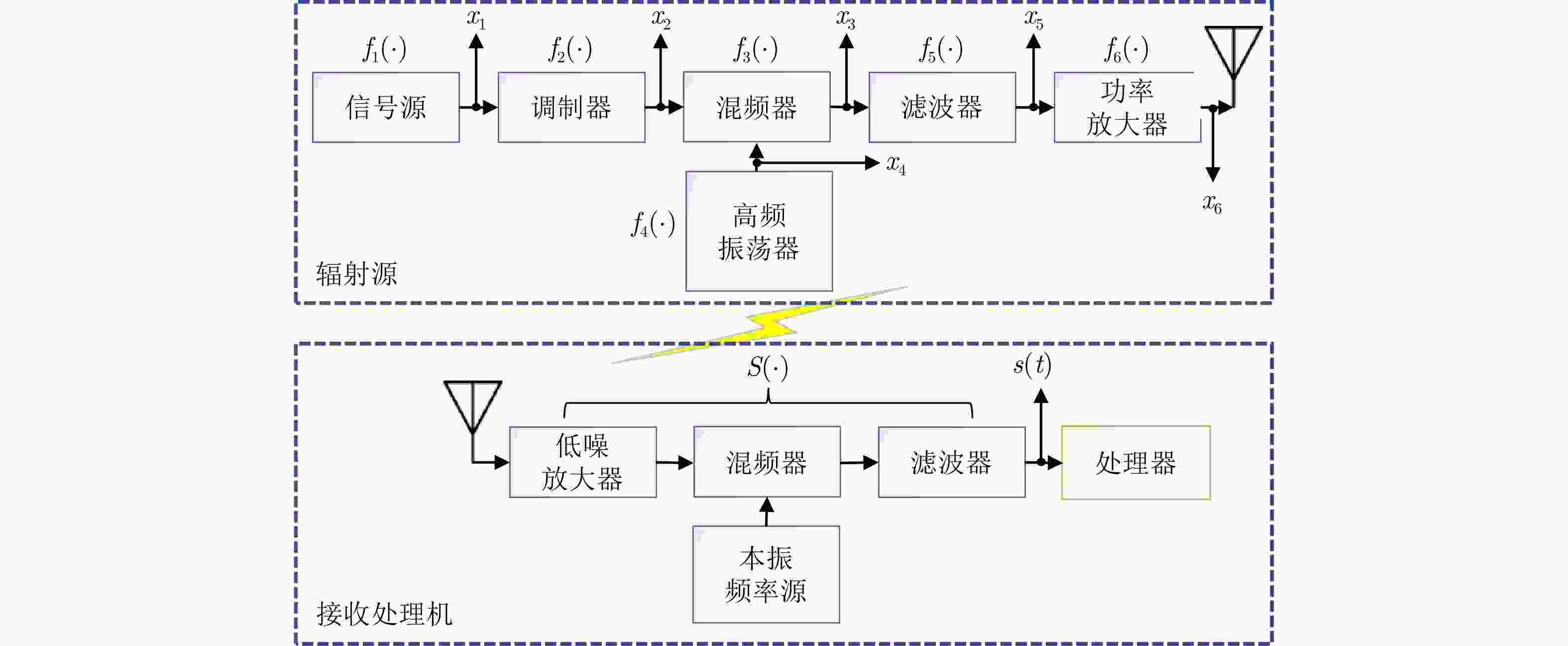
 下载:
下载:


